Samsung Galaxy S 2 (International) Review - The Best, Redefined
by Brian Klug & Anand Lal Shimpi on September 11, 2011 11:06 AM EST- Posted in
- Smartphones
- Samsung
- Galaxy S II
- Exynos
- Mobile
The other part of the story is Samsung’s mobile Digital Natural Image engine, or mDNIe, profile set on the SGS2. Numerous people have noticed that under Display -> Background Effect, lurks a page with a sample image and three presets - Dynamic, Standard, and Movie.
On previous Galaxy S devices there was a box in the camera app marked ‘outdoor viewing’ which increased brightness and contrast. I always wondered how that worked, and the answer is through mDNIe profiles. Inside /system/etc/ are a bunch of files prefixed with ‘mdnie_tune’ and then some more text, for example ‘mdnie_tune_camera_outdoor_mode’ and ‘mdnie_tune_standard_mode’. Of course, these are how the various settings are defined, and there are a bunch of them.
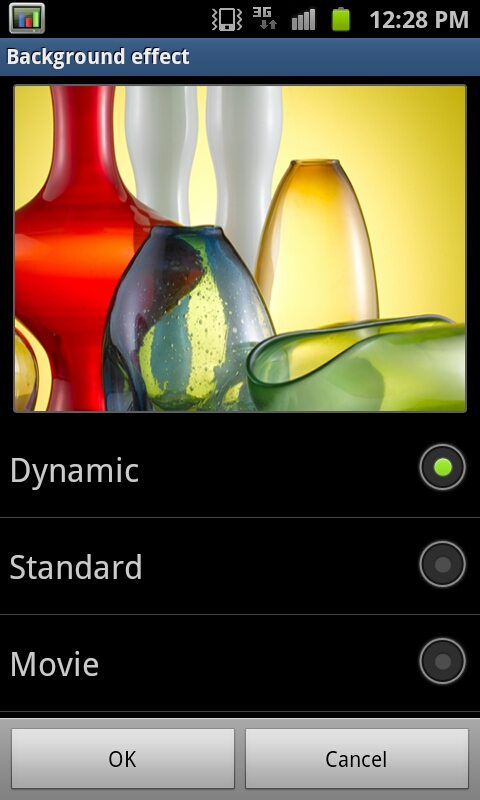
Inside are settings which control sharpening, saturation, and other things which are governed by mDNIe. For example, the mdnie_tune_ui_standard_mode file looks like this:
//start 0x0001,0x0000, // 0x002c,0x0fff, //DNR bypass 0x003C 0x002d,0x1900, //DNR bypass 0x0a08 0x002e,0x0000, //DNR bypass 0x1010 0x002f,0x0fff, //DNR bypass 0x0400 0x003A,0x000d, //HDTR DE_off CS : de on = d , de off = 9 0x003B,0x0001, //DE SHARPNESS(0~1023) off 0x003C,0x0000, //NOISE LEVEL 0x003F,0x001e, //CS GAIN 30 0x0042,0x0030, //DE TH (MAX DIFF) 0x0028,0x0000, //Register Mask //end
Movie and Standard just differ in CS (Chroma Saturation) Gain (from 30 to 50), and dynamic boosts that to 300 along with another field whose purpose I’m not certain of. I’m told by Francois that Dynamic also changes white point through mDNIe by clamping and thus results in some dynamic range being lost. Unfortunately there’s no - everything off - mode with no sharpening or chroma gain that makes colors less oversaturated out of the box, though if you have root obviously you can change and experiment with these. Now that we’ve mentioned it, all measurements I’ve done on the SGS2 were in the Standard mode.
Now what about brightness across the spectrum of user-selected intensity percentages?
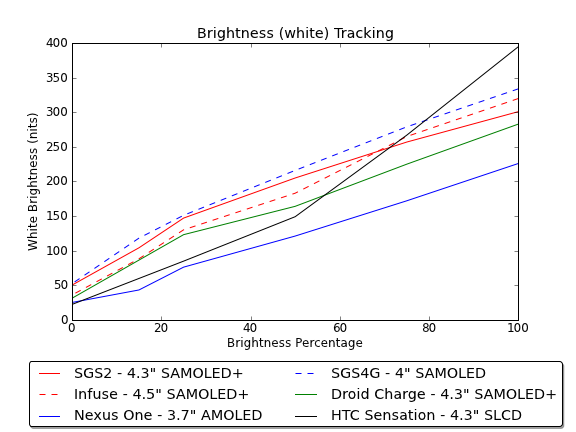
It’s redundant to show black brightness since each device measures 0 nits due to black pixels not emitting any light, so AMOLED remains super contrasty, even if brightness is about the same with SAMOLED+ as it was with SAMOLED. Thankfully the curve is nice and linear.
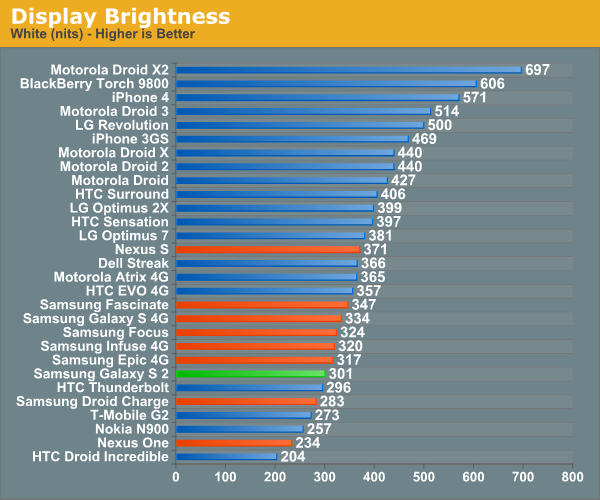
On the big display graph though, SAMOLED+ still isn’t as bright as the competition, though again having infinite contrast does make the display subjectively awesome indoors.
Outdoors SAMOLED+ is about the same as the previous generation. It isn’t very easy to see the display contents outside in direct sunlight, but then again what phone does look as good outside as it does inside? SAMOLED+ as mentioned earlier still leverages the optical bonding benefits (fewer reflections) that SAMOLED brought, so if you were pleased with view-ability there expect much of the same with this update.
The only major issue outdoors is something else entirely. I noticed pretty quickly with the Infuse 4G and Droid Charge that outside in my climate’s environment (~100+F outdoor temps, lots of sunlight) that the phones would clamp brightness to about 75% to prevent overheating. This is in part a measure to protect the display panel and of course other internal components. I set out to find out whether SGS2 implements the same thermal restrictions, and it does.
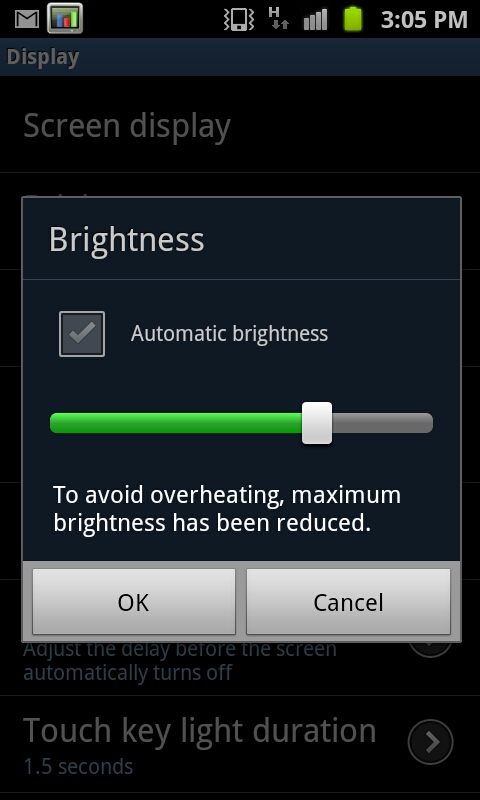
I broke out my contactless IR thermometer and went outside into the midday sun on my patio and set the phone down. Overheating and clamping down the display brightness doesn’t take long in this climate, about 5–10 minutes will do it. At around 115F (~45C) surface display temperature you’ll get clamped to 75% maximum until temperature drops down. I actually subjectively don’t think SGS2 is as prone to overheating as the Charge or Infuse.
Some other people have reported SGS2 crashing or encountering a thermal shutoff after a certain point, so I braved the heat and stayed outside even longer using the device until it hit well over 140F (60C) and still no system shutdown or overheating happened. That’s not to say it isn’t possible, as the SGS2 clearly does have thermal monitoring, for example the following lines from dmesg suggest some thermal monitoring going on, though I definitely crossed these boundaries to no ill effects:
<6>[ 0.047638] thr_low: 83, thr_high: 98 warn_low: 97 c warn_high 106 <6>[ 0.047715] tq0_signal_handle_init <6>[ 0.047751] tmu_initialize: te_temp = 0x00000048, low 8bit = 72,high 24 bit = 0 <6>[ 0.047765] Compensated Threshold: 0x7d <6>[ 0.098087] Cooling: 82c THD_TEMP:0x80: TRIG_LEV0: 0x89TRIG_LEV1: 0x99 TRIG_LEV2: 0xa0
Back to the display, next up are viewing angles, which the SGS2 thankfully preserves from the previous generation. I tossed the SGS2, SGS4G, and Optimus 2X in the lightbox and took pictures at various extreme angles. I realize the Sensation is a comparison point people are interested in, unfortunately that went back a while ago.
Viewing angles are awesome on all three - the SGS4G’s SAMOLED display (left), SGS2’s SAMOLED+ (middle), and Optimus 2X’s IPS display (right).
Another small thing about the SGS2’s SAMOLED+ is that I’ve noticed that high contrast images can be persistent for a few seconds. It isn’t burn-in, but a persistence that stays for a few seconds and can be very visible. For example, leaving the Android keyboard up (which is black, grey, and white) and dragging the shade down, a shadow of the keyboard remains visible until it fades after a few seconds. This persists even on other applications as well, and I can only hope doesn’t become something permanent if left up too long.
Wrapping up SAMOLED+ is difficult, because whether or not you like it over traditional LCD alternatives is ultimately a very subjective (and as I’ve learned in discussions, sensitive) matter. We’ve codified the differences between SAMOLED+ and previous generations, and other IPS displays, but really it’s impossible to communicate every subtle difference.
Personally, I prefer higher PPI IPS-LCD displays, though at 4.3“ SAMOLED+’s WVGA (800x480) isn’t a slouch, and the change from RGBG PenTile to an RGB stripe helps matters. Where WVGA starts to become a problem is at 4.5”. Scaling up area and increasing the diagonal size by 0.2“ doesn’t sound like a problem, but r^2 is a bitch, and at that size both the Android UI elements and subpixels look absurdly huge. Luckily, the international SGS2’s 4.3” is completely tolerable with WVGA.
MHL
Last but not least, the SGS2 supports HDMI out through USB MHL. For those that haven’t encountered the term before, MHL (Mobile High definition Link) is just a way of getting HDMI out through a low pin-count port alongside supplying power. So far, all MHL I’ve seen has worked over microUSB, but other interfaces possibly may support MHL in the future as well.
I had a Samsung MHL adapter laying around from a Samsung Infuse 4G, which has a microUSB port on the side for connecting to a charger, a full size HDMI port, and the microUSB connector which plugs into the host device. With all this connected, you can then get HDMI mirroring working, which does work on the SGS2.
I connected the SGS2 over HDMI up to an ASUS PA246Q and saw it negotiate a 1080i link and do HDMI mirroring flawlessly. Landscape is also supported, thankfully, and seems to work just like it should.


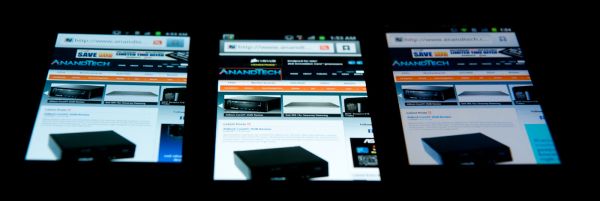






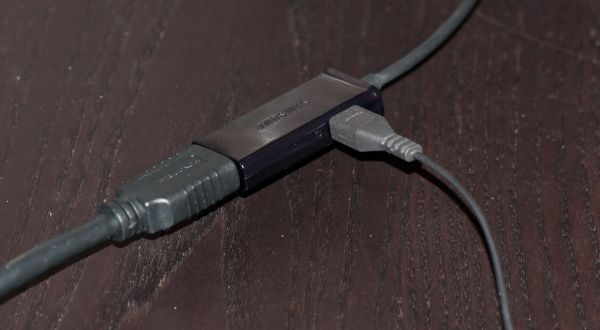
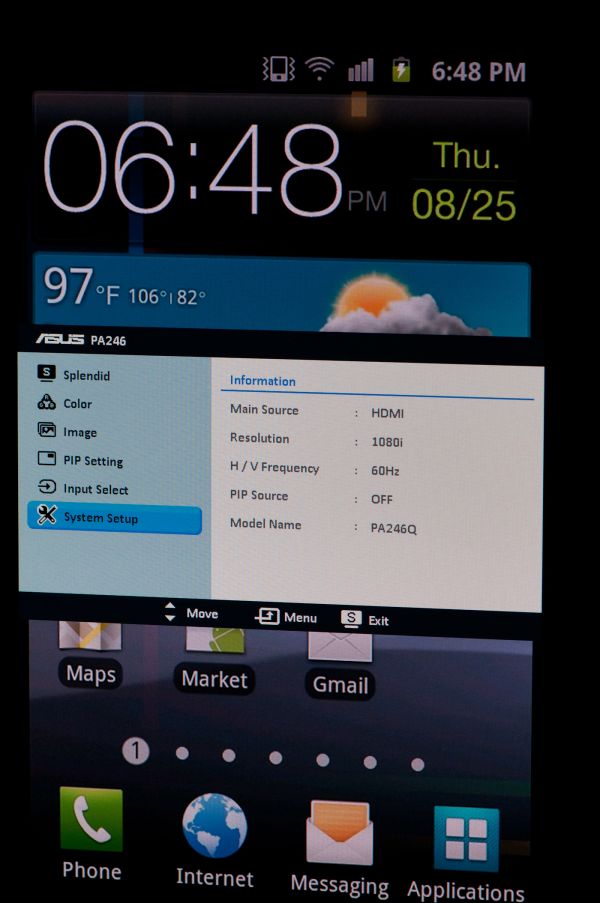








132 Comments
View All Comments
shamalh108 - Monday, September 12, 2011 - link
Thanks alot, going to do that today, however if you read my post above im not sure its an individual app causing it. Maybe i should root so i can wipe the battery stats and recalibrate, besides that im also going to purchase the offical extended battery from samsung, i dont mind losing slight slimness:)ph00ny - Monday, September 12, 2011 - link
I didn't even bother with rooting for a month or two until i wanted to try out chainfire plugins. Even in stock form, battery life was great. certainly better than my captivate.One thing to understand about SAMOLED screen is that it uses 0 power on black pixel and more power on white pixels. So maybe try out a darker themed wall paper and also check to see if you have widgets that have tendency to use up more juice than an alternative
Also for an example, samsung's stock music app uses roughly half of Google's music app power consumption. It gets worse with spotify (offline mode of course)
Remeniz - Monday, September 12, 2011 - link
The trick is to adjust the power saving features to suit and make sure very little is going on in the back ground. I only run GPS if I need too and the WiFi gets turned off when i'm out and about, unless I know i'm in a WiFi zone and want to browse the www.I get at least a days use out of my SGS2.
supercurio - Monday, September 12, 2011 - link
Note:"When idle, processor goes back to 200 MHz"
Idle - screen on or an using a wakelock to keep the device on its the case.
Otherwise the whole CPU is turned literally OFF − everything frozen in RAM.
And in this situation, the baseband, Wi-fi chip or an external timer will wake up the CPU and restore Linux kernel in a working state when needed, like if you received a new mail, or a phone call.
I precise that because most people believe the CPU stays ON all the time but it's the opposite, with standard usage, the CPU is ON only a fraction of the day.
Lucian Armasu - Sunday, September 11, 2011 - link
Brian, I don't think it's fair to compare the "tablet" version of A5 with the "smartphone" version of the Exynos and all the other chips. Even Nvidia's Tegra 2 has either 50% or 100% higher clock frequency for its GPU in the tablets, compared to the one in smartphones.It's very likely that all tablet chips are more powerful than the smartphones ones, and for all we know the iPhone 5 GPU will only one 1 GPU core instead of 2 like in the iPad 2, or they'll be clocked at a lower frequency.
I know you'll review the iPhone 5, too, but I think you're setting a too low expectation for the Exynos and the others compared to the "A5 chip". You know what I mean? You should've at least thrown a Xoom or a Transformer in there to see how it fairs against the Tegra 2 phones.
I hope at least you'll correct this in future reviews. Great review otherwise, though.
privater - Sunday, September 11, 2011 - link
An iPad 2 can run sun spider 0.9 with 1980 score (4.3.5)If the Exynos is superior on every aspect of A5, the result is difficult for me to understand.
Lucian Armasu - Sunday, September 11, 2011 - link
Just as I mentioned above, it's not fair to compare the tablet versions with the phone versions of the chips. All the latest smartphones get around 4000 in the Sun Spider test, but all tablets get around 2000 in that test, so even on the CPU side, it's still not a fair comparison.Mike1111 - Sunday, September 11, 2011 - link
Great review!But why are you so late with the review of the INTERNATIONAL version? I mean I would get it if you decided to wait for the US versions, but waiting almost 4 1/2 months and then publish a review of the international version only a week before the US versions get released? Seems strange to me...
ph00ny - Sunday, September 11, 2011 - link
Brian said in the other reviews comment sections that he was waiting to get ahold of a review unit. I did offer mine if he was nearby but he's nearly on the west coast and i live in the opposite side of the countryshamalh108 - Sunday, September 11, 2011 - link
Another pity is that even games from gameloft which are supposed to be adapted to the SGS2 cause significant heating of the phone.. for example the Asphalt 6 available for free in Samsung Apps .. it would be great if more games were coded to make better use of the SGS2 gpu ...